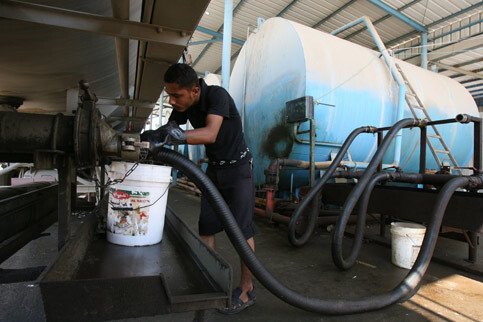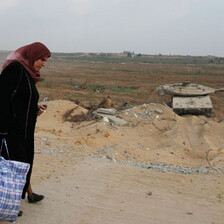The Electronic Intifada 26 June 2008

Palestinian fuel trucks at the Nahal Oz crossing on the border of Israel and the Gaza Strip refuel for Gaza’s power plant hours after an Egyptian-brokered ceasefire went into effect between Hamas and Israel earlier that morning, 19 June 2008. (Wissam Nassar/MaanImages)
A ceasefire went into effect in Gaza last week, offering some respite from the violence that has killed hundreds of Palestinians and five Israelis in recent months. It will do nothing, however, to address the underlying cause of the Israeli-Palestinian conflict.
Intermittent spectacular violence may draw the world’s attention to the occupied Palestinian territories, but our obsession with violence actually distracts us from the real nature of Israel’s occupation, which is its smothering bureaucratic control of everyday Palestinian life.
This is an occupation ultimately enforced by tanks and bombs, and through the omnipresent threat, if not application, of violence. But its primary instruments are application forms, residency permits, population registries and title deeds. On its own, no ceasefire will relieve the beleaguered Palestinians.
Gaza is virtually cut off from the outside world by Israeli power. Elsewhere, in the West Bank and East Jerusalem, the ongoing Israeli occupation comprehensively infuses all the normally banal activities of Palestinians’ everyday lives: applying for permission to access one’s own land; applying for what Israel regards as the privilege — rather than the right — of living with one’s spouse and children; applying for permission to drive one’s car; to dig a well; to visit relatives in the next town; to visit Jerusalem; to go to work; to school; to university; to hospital. There is hardly any dimension of everyday life in Palestine that is not minutely managed by Israeli military or bureaucratic personnel.
Partly, this occupation of everyday life enables the Israelis to maintain their vigilant control over the Palestinian population. But it also serves the purpose of slowly, gradually removing Palestinians from their land, forcing them to make way for Jewish settlers.
Just in 2006, for example, Israel stripped 1,363 Jerusalem Palestinians of the right to live in the city in which many of them were born. It did this not by dramatically forcing dozens of people at a time onto trucks and dumping them at the city limits, but rather by quietly stripping them, one by one, of their Jerusalem residency papers.
This in turn was enabled by a series of bureaucratic procedures. While Israel continues to violate international law by building exclusively Jewish settlements in East Jerusalem, it rarely grants building permits to Palestinian residents of the same city. Since 1967, the third of Jerusalem’s population that is Palestinian has been granted just nine percent of the city’s official housing permits. The result is a growing abundance of housing for Jews and a severe shortage of housing for non-Jews — i.e., Palestinians.
In fact, 90 percent of the Palestinian territory Israel claimed to have annexed to Jerusalem after 1967 is today off-limits to Palestinian development because the land is either already built on by exclusively Jewish settlements or being reserved for their future expansion.
Denied permits, many Palestinians in Jerusalem build without them, but at considerable risk: Israel routinely demolishes Palestinian homes built without a permit. This includes over 300 homes in East Jerusalem demolished between 2004 and 2007 and 18,000 Palestinian homes in the occupied territories demolished since 1967.
One alternative has been to move to the West Bank suburbs and commute to Jerusalem. The wall cutting off East Jerusalem from the West Bank and thereby separating tens of thousands of Jerusalem Palestinians from the city of their birth has made that much more difficult.
And it too has its risks: Palestinians who cannot prove to Israel’s satisfaction that Jerusalem has continuously been their “center of life” have been stripped of their Jerusalem residency papers. Without those papers, they will be expelled from Jerusalem, and confined to one of the walled-in reservoirs — of which Gaza is merely the largest example — that Israel has allocated as holding pens for the non-Jewish population of the holy land.
The expulsion of half of Palestine’s Muslim and Christian population in what Palestinians call the Nakba of 1948 was undertaken by Israel’s founders in order to clear space in which to create a Jewish state.
The Nakba did not end 60 years ago, however: It continues to this very day, albeit on a smaller scale. Yet even ones and twos eventually add up. Virtually every day, another Palestinian joins the ranks of the millions removed from their native land and denied the right of return.
Their long wait will end — and this conflict will come to a lasting resolution — only when the futile attempt to maintain an exclusively Jewish state in what had previously been a vibrantly multi-religious land is abandoned.
Separation will always require threats or actual violence; a genuine peace will come not with more separation, but with the right to return to a land in which all can live as equals. Only a single democratic, secular and multicultural state offers that hope to Israelis and Palestinians, to Muslims, Jews and Christians alike.
Saree Makdisi is professor of English literature at the University of California, Los Angeles and author of “Palestine Inside Out: An Everyday Occupation.” This article originally appeared in the The International Herald Tribune and is republished with the author’s permission.




